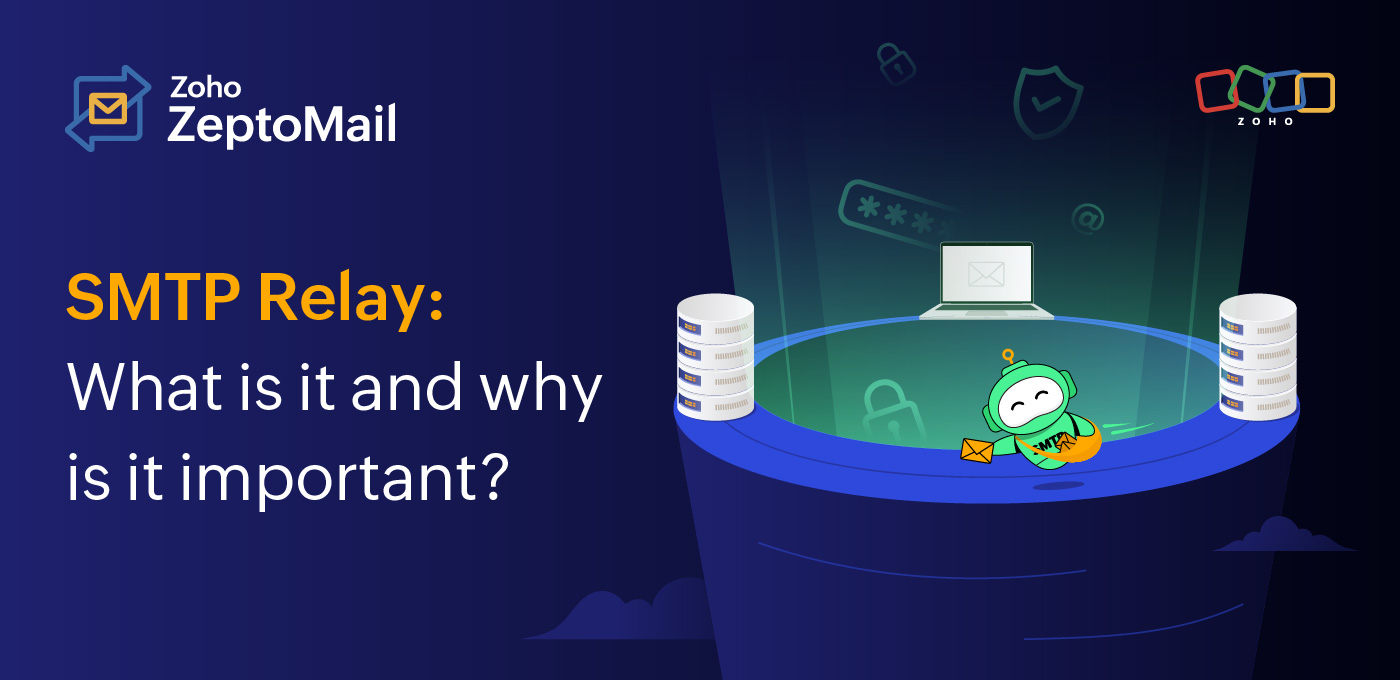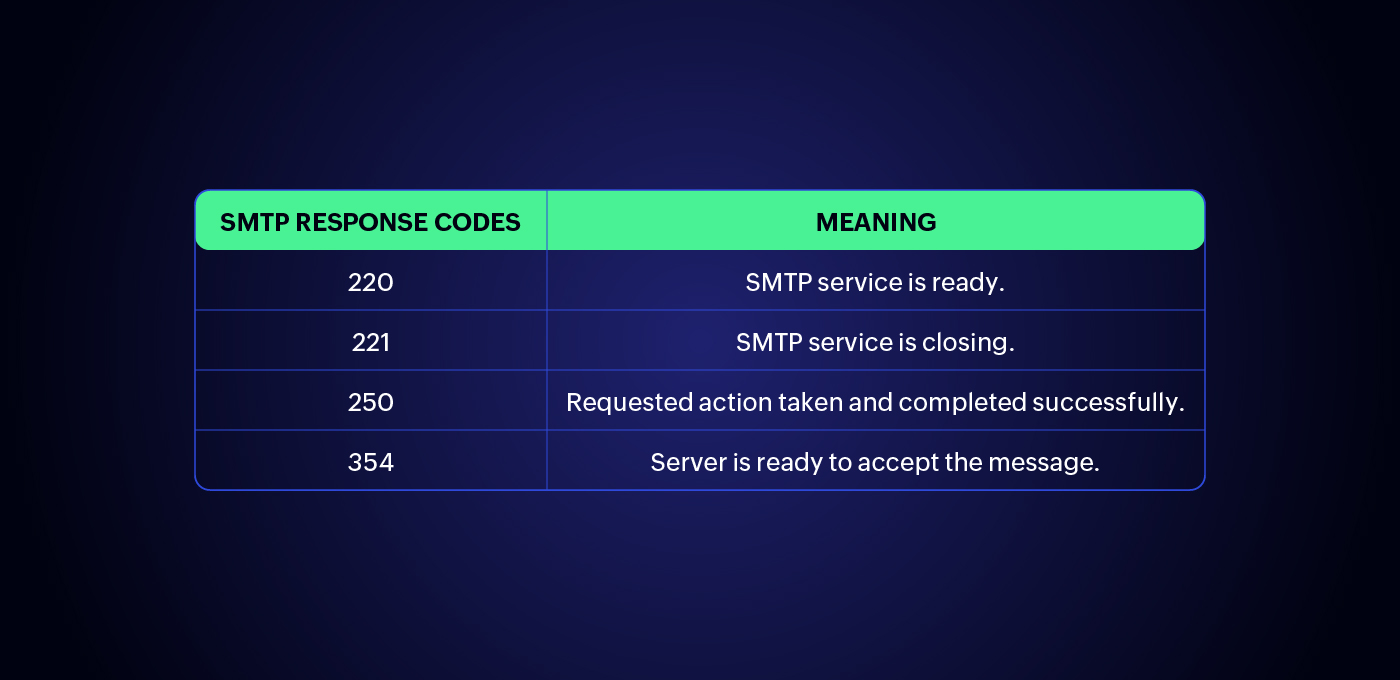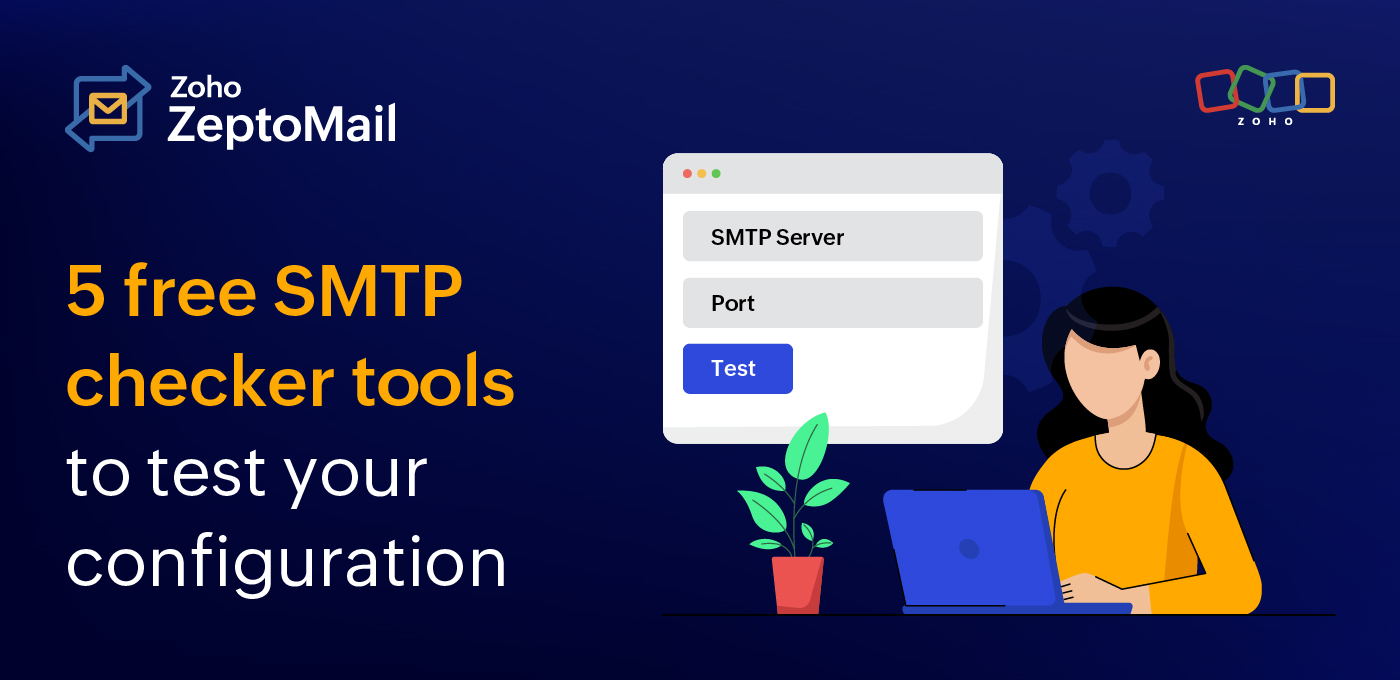- HOME
- Deliverability
- SMTP Relay: What is it, and why is it important?
SMTP Relay: What is it, and why is it important?
- Published : March 31, 2025
- Last Updated : March 31, 2025
- 93 Views
- 8 Min Read
Previously, we explored what SMTP is. In this article, we'll delve into how the SMTP relay process works. Let's dive in and uncover everything about SMTP relay.
What's the first thing that comes to your mind when you think of the term "SMTP relay"? If you had thought of a relay race, then we're on the same page.
Just like in a relay race where runners pass the baton to one another, SMTP relay works in a similar way. Here, the "baton" represents the "email message," and the "runners" are "SMTP servers". The process involves transferring the email from one SMTP server to another until it finally reaches the recipient's inbox.
This is just a clear idea of SMTP relay but to understand it more clearly, let's look into the technicalities that go behind the SMTP relay.
What is an SMTP relay?
An SMTP relay is the process of transferring an email from one mail server to another using the Simple Mail Transfer Protocol (SMTP). It acts as a middleman, ensuring that emails are correctly routed from the sender to the recipient’s inbox.
Imagine you're traveling to a country where you don't speak the language. You'll need a translator to convey your message accurately. That’s exactly what SMTP does for your emails. It acts as a reliable messenger, using simple language and transmitting your email from your application or website to the recipient’s server—ensuring smooth, uninterrupted delivery.
SMTP vs. SMTP relay
While SMTP and SMTP relay are closely related, they serve different roles in email communication.
SMTP is simply an email protocol that defines the rules for seamless communication between mail servers, ensuring efficient email delivery.
SMTP relay works like a relay system, where servers transfer emails from one to another with the help of SMTP until they successfully reach the intended recipient.
Understanding SMTP servers, ports, responses codes and commands
Before we get into how SMTP works, let's get to know the technical terms and other important things that are involved while sending emails.
What are SMTP servers?
When you hit “send,” your email client (like Gmail or Outlook) connects to an SMTP server to deliver your message. The server checks the recipient’s address and forwards the email to the correct destination, even if it has to pass through multiple servers along the way.
What is an SMTP port?
An SMTP port is a network port used by the Simple Mail Transfer Protocol to transmit emails between servers and email clients. Ports are communication endpoints that allow data to be sent and received over a network.
There are several commonly used SMTP ports:
- Port 25: This is the default SMTP port for email transmission across the Internet. It's primarily used for relaying emails between servers. This port doesn't do any encryption.
- Port 587: This is the modern default port for sending emails securely using SMTP. It supports encryption via STARTTLS, making it a preferred choice for email clients to send outgoing messages.
- Port 465: Originally designated for SMTPS (SMTP Secure) before STARTTLS became widespread. It's still used by some email services for encrypted transmission, though it's less common today.
What are SMTP response codes?
SMTP response codes are three-digit numbers sent by email servers to indicate the status of an email transaction.These SMTP codes ensure smooth communication between sending and receiving servers. Here's a list of basic SMTP response codes used while communicating between two or multiple servers.
What are the common SMTP error codes?
SMTP 421: Your email was temporarily deferred due to too many connections or excessive messages sent within a short period.
SMTP 450: Delivery failed because the recipient’s mailbox was unavailable—this may occur if the mailbox is locked or unroutable.
SMTP 451: The email failed to send, typically due to an issue on the recipient’s server rather than your end.
SMTP 452: The email was deferred because the recipient server lacked sufficient storage. Delivery will be retried when space is available.
SMTP 550: The recipient's mailbox is unavailable, or the email was rejected by the recipient server.
SMTP 551: The intended recipient’s mailbox doesn't exist on the destination server.
SMTP 552: The recipient’s mailbox is full and unable to accept new messages.
SMTP 553: Delivery failed because the specified recipient address doesn't exist.
SMTP 554: A generic error message indicating that the email was rejected due to various possible issues on your server or the recipient's server.
How does SMTP relay work?
Now that we've learned what SMTP relay is, let's get to know how SMTP relay works. This could be explained in different ways based on your level of understanding. Here are four different ways that you can choose from to make you get the SMTP relay mechanism better.
A. An overview of the key processes involved in email transfer.
B. An analogy of how SMTP relay works.
C. Behind-the-scenes technicalities that go behind email transmission using SMTP.
D. Pictorial representation of how SMTP relay works during email transmission.
A. Key processes involved in SMTP relay
- Initiation: The sender initiates an email through the mail client (like Outlook, Zoho Mail, or Gmail).
- Authentication: The SMTP server validates the sender.
- Routing: SMTP identifies and connects to the recipient’s server.
- Transmission: The recipient server receives the email or queues it for delivery.
B. SMTP relay explained with an analogy
Imagine John (the sender) wants to send a courier to George (the recipient).
1. Packing the parcel (mail client): John carefully gathers the items (content or data) he wants to send and writes important information like the sender and recipient addresses (similar to the "To" and "From" fields in an email).
2. Visiting the courier center: John drops off the parcel at a local courier service center (the mail server).
3. At the courier center (server):
- Authenticity check: The courier staff verifies the sender’s identity, confirms the recipient's address and contact details, and makes sure everything is in order (like how a server checks an email’s authenticity).
- Stamp and seal: Once approved, they add a stamp and seal to the parcel, ensuring it’s ready to be dispatched (just like how the server marks an email as authenticated and ready for delivery).
4. Transporting the parcel (SMTP in action): The courier service assigns the parcel to a reliable courier agent (SMTP), who transports it to a nearby service center at George’s location. The local courier center confirms that the parcel is correctly routed (like verifying the recipient’s email server).
5. Delivering the parcel (with the help of SMTP): Finally, a delivery agent (SMTP) ensures that the parcel reaches George’s door (recipient mail client). If all goes well, George receives the package, just as the recipient receives the email.
C. Understanding the technicalities of email transmission with the help of SMTP
Now let's get into the technical part. Let's see what happens behind the scenes right after you click the "Send" button after typing an email.
- When you click the "Send" button after drafting your email, a Transition Control Protocol (TCP) connection is established and this links you to an SMTP server.
- Once the SMTP server connection is established, email clients can easily connect and communicate to each other with the help of SMTP.
- When the SMTP server receives the TCP connection from a client, then the SMTP process starts a connection through port 25 to send the email.
- The SMTP client then communicates with the server with the help of commands and tells the server what to do.
- With the help of commands, the SMTP client can include the sender's address, the recipient's address, transfer data, or email content.
- Now, MTA Mail Transfer Agent (MTA) checks the entered email addresses. It sees whether the addresses are from the same email domain (like gmail.com, zohomail.com) or a different one.
- If the addresses are from the same email domain, then the communication is done immediately
- If the addresses are from different email domain, the server uses the Domain Name System (DNS) and tries to identify the recipient's domain. Then it's sent to the right server for the recipient.
D. Pictorial representation of the transmission of message via SMTP
Why should you consider a SMTP relay service?
Maybe you think that you don’t need an SMTP relay service because you can manage emails yourself. Sure, self-management is possible, but ensuring security, scalability, and analytics as a one-person army is a challenge. It’s not just about doing it alone—it’s about doing it efficiently. An SMTP relay service simplifies everything for you.
1. Handle bounces and retrieve
When sending emails in bulk, managing bounced emails is crucial. SMTP relay services like ZeptoMail can automatically handle hard and soft bounces, ensuring your sender reputation stays intact. By understanding bounce patterns, you can refine your email strategy and maintain high deliverability rates.
2. Send large volumes without daily limits
Most Internet Service Providers (ISPs) have sending limits for outgoing emails. SMTP relay services allow businesses to send high volumes of transactional email without restrictions. One such SMTP relay provider is Zoho ZeptoMail.
3. Stay away from IP blacklisting
If you send too many emails from your own server, you risk getting your IP address blacklisted. SMTP relay services use reputable IPs and warm-up processes to maintain a good sender reputation for the emails you send.
4. Best security for your sensitive data
SMTP relay services don't stop with providing authentication checks but also provide in-transit security (TLS/SSL encryption). This helps you protect sensitive data and prevent unauthorized email spoofing or phishing attacks.
5. Track to get comprehensive reports
Most SMTP relay providers offer detailed insights into email performance, including delivery rates, open rates, click rates, and bounce tracking, helping you optimize your email campaigns.
6. Reliable and dedicated infrastructure
SMTP relay services have dedicated mail servers optimized for high performance and uptime, ensuring that emails are sent quickly and reliably without overloading your own servers.
7. Less hassle and more hustle
Managing emails manually can be complex. With an SMTP relay service, you get centralized management tools to organize, segment, measure, and analyze your entire email sending process.
How to choose a SMTP relay email service provider?
When selecting an SMTP relay provider, consider these key factors to ensure seamless email delivery and reliability.
1. It maintains a separate infrastructure
The foremost thing to check is the infrastructure. Always choose a SMTP relay service provider that has a separate stream to send your transactional emails. This can boost your email deliverability.
2. Focuses on email deliverability
Look for a provider with a strong sender reputation, high deliverability rates, and rapid email delivery. Ensure that they also have proactive measures to prevent emails from landing in your spam folder.
3. Scalability and performance
Choose a service that can handle your email volume, whether you’re sending thousands or millions, without delays or failures.
4. Security and compliance
Ensure that the provider offers encryption, authentication (SPF, DKIM, DMARC), and compliance with email regulations like GDPR and CAN-SPAM.
5. Monitoring and analytics
A good provider should offer real-time tracking, bounce handling, open/click metrics, and detailed logs for troubleshooting.
6. Pricing and support
Compare pricing plans based on your sending needs and check for responsive customer support to resolve issues quickly.
Why should you try ZeptoMail as your SMTP relay service?
Now, imagine you run a bank. At any given moment, 5,000 people may request OTPs for log in, while 50,000 others are receiving transaction confirmations simultaneously. While it’s technically possible to handle these emails yourself, there are significant limitations.
Most email clients impose daily sending limits. Exceeding these limits increases the likelihood of transactional emails being undelivered or flagged as spam. These failures can disrupt customer experience and impact business operations. So, ensuring these emails are delivered instantly, securely, and without failure is critical. This is where Zoho ZeptoMail steps in.
Zoho ZeptoMail provides a dedicated infrastructure optimized for high-volume transactional email delivery. By following proper email protocols, ZeptoMail allows businesses to send large volumes of emails. While sending large volumes, ZeptoMail ensures:
- Better bounce management
- Efficient IP and blacklist handling
- Bounce reports with reasons to rectify
- Send authenticated/domain verified emails
- Resending soft bounces
- Suppression lists to handle hard bounces
- Email tracking via webhooks
- Comprehensive and custom reports
- Attachment management
- Built-in templates for different transactional emails
- Processed email status for verification
With ZeptoMail, you don’t have to worry about deliverability, security, or email failures. Instead, you can focus on growing your business while ensuring every transactional email reaches the right inbox at the right time.
Wrapping up
As we wrap up, you now understand the crucial role that SMTP plays in email transmission, and how fascinating the process behind email delivery is. We hope this article has helped you understand how SMTP relay works and how to choose the right SMTP relay service for your business.
Remember, by leveraging the right SMTP relay service, you can improve deliverability, manage bounces effectively, and gain valuable insights into your email performance. Whether you're sending transactional or bulk emails, a robust SMTP relay solution helps you maintain efficiency and compliance.













